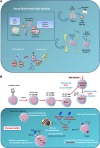Current issues in chronic graft-versus-host disease
- PMID: 24914139
- PMCID: PMC4102710
- DOI: 10.1182/blood-2014-01-514752
Current issues in chronic graft-versus-host disease
Abstract
Chronic graft-versus-host disease (GVHD) is a frequent and potentially life-threatening complication of allogeneic hematopoietic stem cell transplantation. Increased transplantation of older patients and the more frequent use of unrelated donors has led to increased numbers of patients with this painful complication. Recent advances have been made in understanding the pathophysiology of chronic GVHD and in establishing precise criteria for diagnosis and classification of disease manifestations. These advances will hopefully pave the way for improving both the prophylaxis and treatment of chronic GVHD.
© 2014 by The American Society of Hematology.
Figures





References
-
- Socié G, Stone JV, Wingard JR, et al. Late Effects Working Committee of the International Bone Marrow Transplant Registry. Long-term survival and late deaths after allogeneic bone marrow transplantation. N Engl J Med. 1999;341(1):14–21. - PubMed
-
- Filipovich AH, Weisdorf D, Pavletic S, et al. National Institutes of Health consensus development project on criteria for clinical trials in chronic graft-versus-host disease: I. Diagnosis and staging working group report. Biol Blood Marrow Transplant. 2005;11(12):945–956. - PubMed
-
- Shulman HM, Kleiner D, Lee SJ, et al. Histopathologic diagnosis of chronic graft-versus-host disease: National Institutes of Health Consensus Development Project on Criteria for Clinical Trials in Chronic Graft-versus-Host Disease: II. Pathology Working Group Report. Biol Blood Marrow Transplant. 2006;12(1):31–47. - PubMed
Publication types
MeSH terms
Grants and funding
LinkOut - more resources
Full Text Sources
Other Literature Sources

